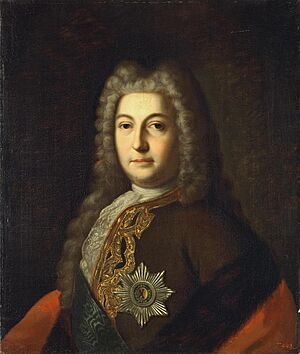Andrey Osterman facts for kids
Quick facts for kids
Andrey Ostermann
|
|
|---|---|
| Андрей Остерман | |
 |
|
| Minister of Foreign Affairs of Russia | |
| In office 1734–1740 |
|
| Monarch | Empress Anna Emperor Ivan VI Grand Duchess Anna Leopoldovna |
| Preceded by | Gavriil Golovkin |
| Succeeded by | Alexey Cherkassky |
| Personal details | |
| Born |
Heinrich Johann Friedrich Ostermann
9 June 1686 |
| Died | 31 May 1747 (aged 60) |
Count Andrey Ivanovich Ostermann (born Heinrich Johann Friedrich Ostermann; 9 June 1686 – 31 May 1747) was a very important government official in Russia. He was born in Germany but became a key advisor to several Russian rulers. He started working for Peter the Great and continued to serve until 1741. Ostermann was known for his smart ideas about how Russia should deal with other countries. He believed Russia should be friends with Austria. He also became a General Admiral in the navy.
Contents
Becoming a Key Advisor
Andrey Ostermann was born in a town called Bochum in Germany. His father was a pastor. His original name was Heinrich Johann Friedrich Ostermann. He was very good at learning languages. He studied at the University of Jena and learned German, Latin, French, Dutch, Italian, and Russian.
His language skills helped him get a job with Vice-Admiral Cornelis Kruse. This admiral was looking for smart young people for Peter the Great. Soon, Ostermann joined the Tsar's service. His ability to speak many European languages made him a valuable helper to Vice-Chancellor Shafirov. He played a big part in important talks, like the ones that ended the peace of the Pruth in 1711.
Ostermann also represented Russia at a peace meeting in Åland in 1718. He was very clever and realized that Sweden was tired of fighting. He advised Peter the Great to push Sweden harder to make peace.
Smart Diplomacy
In 1721, Ostermann helped Russia make a peace deal with Sweden called the Peace of Nystad. Because of his great work, he was given the title of baron. In 1723, he helped Russia sign a very good trade agreement with Persia. For this, he became the vice-president of the foreign affairs department.
Peter the Great often asked Ostermann for advice on things happening inside Russia too. Ostermann introduced many new ideas for how the government should work. For example, he helped create the "Table of Ranks," which was a system that organized government and military jobs. He also helped make the foreign affairs department more modern.
When Catherine I of Russia became empress (1725–1727), Ostermann's power grew even more. He was in charge of all foreign affairs. He also managed trade and the postal service.
When Peter II of Russia became emperor, Ostermann was chosen to be his teacher and guide. After Peter II died in 1730, some powerful families tried to change Russia into a country with a limited monarchy. But Ostermann stayed out of it. He waited until Empress Anne was firmly in charge as the sole ruler. Then, he was rewarded for his loyalty.
His deep knowledge of how other countries worked made him very important to Empress Anne. She and her advisors always listened to him. He even suggested that Russia should have a cabinet system, which is a group of top advisors.
Many good changes in Russia between 1730 and 1740 came from Ostermann's ideas. He helped improve trade, lower taxes, and encourage new businesses. He also made the justice system better and helped Russia gain more respect from other countries. As the foreign minister, he was careful but strong when war was needed. His smart diplomacy led to successful endings for the War of the Polish Succession (1733–1735) and the Russo-Turkish War (1735–1739).
At the Height of Power
During the short time when Anna Leopoldovna was in charge (October 1740-December 1741), Ostermann was at the peak of his power. The French ambassador even said that Ostermann was "tsar of all Russia."
Ostermann's main foreign policy goal was to keep Russia allied with Austria. He had promised to support Austria. Because Russia was Austria's friend, France wanted to weaken Russia. France tried to get Sweden to declare war on Russia, which happened in August 1741. However, Ostermann had already prepared for such a situation. Russia quickly defeated the Swedish army, ending the threat from Sweden.
His Downfall
It became clear to the French ambassador that the only way to remove Ostermann was through a revolution. He decided to support Elizabeth, Peter the Great's daughter, to become empress. Elizabeth disliked Ostermann because she felt he had ignored her, even though he owed his success to her father.
So, on December 6, 1741, there was a sudden change in power, and Ostermann was the first important person to be arrested. He was accused of helping Empress Anne come to power and of hiding a will from Catherine I that would have favored Elizabeth.
Ostermann asked the new empress for mercy. He was first sentenced to a harsh punishment and execution. But at the last moment, his sentence was changed. He and his family were sent away for life to a far-off place in Siberia called Berezov. He died there six years later in 1747.
Ostermann's children were allowed to return to the court during the reign of Catherine the Great. His older son, Feodor Andreevich (1723–1804), became a senator and governor of Moscow. Another son, Ivan Andreevich (1725–1811), was Russia's ambassador in Sweden and later served as the Chancellor of the Russian Empire for 16 years. After Ivan's death, the Ostermann family titles and lands went to his nephew, Alexander Ivanovich Tolstoy.
Images for kids
See Also


